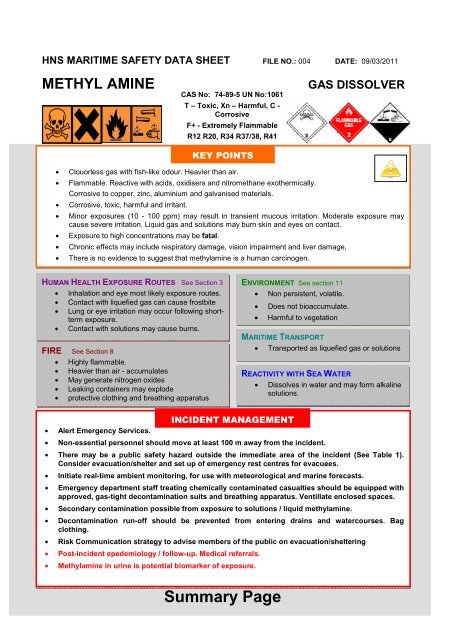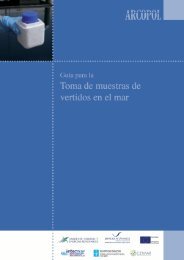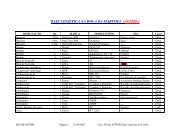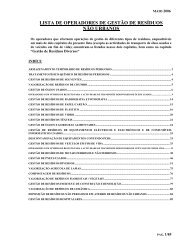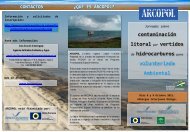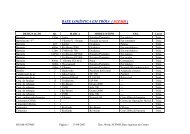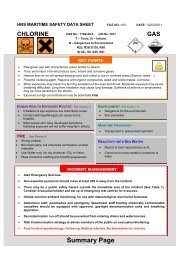methyl amine gas dissolver - Arcopol.eu
methyl amine gas dissolver - Arcopol.eu
methyl amine gas dissolver - Arcopol.eu
Create successful ePaper yourself
Turn your PDF publications into a flip-book with our unique Google optimized e-Paper software.
HNS MARITIME SAFETY DATA SHEET FILE NO.: 004 DATE: 09/03/2011<br />
METHYL AMINE<br />
CAS No: 74-89-5 UN No:1061<br />
T – Toxic, Xn – Harmful, C -<br />
Corrosive<br />
F+ - Extremely Flammable<br />
R12 R20, R34 R37/38, R41<br />
S9, S16, S26, S36, S39<br />
KEY POINTS<br />
GAS DISSOLVER<br />
• Clouorless <strong>gas</strong> with fish-like odour. Heavier than air.<br />
• Flammable. Reactive with acids, oxidisers and nitromethane exothermically.<br />
Corrosive to copper, zinc, aluminium and galvanised materials.<br />
• Corrosive, toxic, harmful and irritant.<br />
• Minor exposures (10 - 100 ppm) may result in transient mucous irritation. Moderate exposure may<br />
cause severe irritation. Liquid <strong>gas</strong> and solutions may burn skin and eyes on contact.<br />
• Exposure to high concentrations may be fatal.<br />
• Chronic effects may include respiratory damage, vision impairment and liver damage,<br />
• There is no evidence to suggest that <strong>methyl</strong><strong>amine</strong> is a human carcinogen.<br />
HUMAN HEALTH EXPOSURE ROUTES See Section 3<br />
• Inhalation and eye most likely exposure routes.<br />
• Contact with liquefied <strong>gas</strong> can cause frostbite<br />
• Lung or eye irritation may occur following shortterm<br />
exposure.<br />
• Contact with solutions may cause burns.<br />
FIRE See Section 8<br />
• Highly flammable.<br />
• Heavier than air - accumulates<br />
• May generate nitrogen oxides<br />
• Leaking containers may explode<br />
• protective clothing and breathing apparatus<br />
ENVIRONMENT See section 11<br />
• Non persistent, volatile.<br />
• Does not bioaccumulate.<br />
• Harmful to vegetation<br />
MARITIME TRANSPORT<br />
• Transported as liquefied <strong>gas</strong> or solutions<br />
REACTIVITY WITH SEA WATER<br />
• Dissolves in water and may form alkaline<br />
solutions.<br />
• Alert Emergency Services.<br />
INCIDENT MANAGEMENT<br />
• Non-essential personnel should move at least 100 m away from the incident.<br />
• There may be a public safety hazard outside the immediate area of the incident (See Table 1).<br />
Consider evacuation/shelter and set up of emergency rest centres for evacuees.<br />
• Initiate real-time ambient monitoring, for use with meteorological and marine forecasts.<br />
• Emergency department staff treating chemically contaminated casualties should be equipped with<br />
approved, <strong>gas</strong>-tight decontamination suits and breathing apparatus. Ventillate enclosed spaces.<br />
• Secondary contamination possible from exposure to solutions / liquid <strong>methyl</strong><strong>amine</strong>.<br />
• Decontamination run-off should be prevented from entering drains and watercourses. Bag<br />
clothing.<br />
• Risk Communication strategy to advise members of the public on evacuation/sheltering<br />
• Post-incident epedemiology / follow-up. Medical referrals.<br />
• Methyl<strong>amine</strong> in urine is potential biomarker of exposure.<br />
PAGE 1 OF 11<br />
Summary Page
HNS MARITIME SAFETY DATA SHEET FILE NO.: 004 DATE: 09/03/2010<br />
METHYL AMINE<br />
GAS DISSOLVER<br />
HUMAN HEALTH CONSIDERATIONS – See Section 3 to 6<br />
ERG 2008 Table 1: Initial isolation and protective action distances<br />
Chemical Name Spill Size Definition<br />
Isolation Zone in DownWind Protection Zone<br />
all directions If Fire No Fire<br />
Methyl<strong>amine</strong><br />
Raw Gas<br />
Flammable Gas. 100 800<br />
1600<br />
All directions<br />
Aqueous<br />
Solution<br />
Flammable Liquid. 50 800<br />
800<br />
All directions<br />
Isolation Distance: All personnel to be directed in a cross wind direction this distance from the spill<br />
Protective Action Zone: A square area down wind of the spill where protective action should be considered, starting with nearest receptors and<br />
working away from spill.<br />
Such estimates should always be regarded with reservations and never be alternatives for monitoring.<br />
Acute Health Hazards<br />
ppm mg m -3 Signs and symptoms<br />
0 - 10 0 – 12.7 No observed effect<br />
5 - 25 6.4 – 32 Slight visual disturbance<br />
10 - 100 12.7 - 127 Transient mucous membrane irritation<br />
100 127 Immediately dangerous to life or health (NIOSH)<br />
Monitoring Strategy (Short & Long Term) & Equipment – See Section 6<br />
Health and Safety<br />
Environmental<br />
Public Health<br />
Air - Real-time photionisation detection or quantitative colour change tubes (Draeger or similar).<br />
Monitors MUST be intrinsically safe / ATEX compliant. Monitor Oxygen in confined spaces<br />
Atmospheric fate and transport e.g. Aloha (immediate risk / first response), Calpuff (longer term)<br />
GP referrals, hospital admissions – numbers, symptomology, follow-up studies. (See Biomarkers)<br />
OPERATIONAL EMERGENCY RESPONSE – See Section 8 & 9<br />
Fire fighting<br />
measures:<br />
Decontamination of<br />
responders<br />
Response &<br />
Clean up:<br />
Waste Management<br />
Use fine water spray for <strong>gas</strong> clouds. Use water to cool tanks, cylinders etc. Use CO 2 or foam<br />
against small fires. May form toxic <strong>gas</strong>es during combustion - Nitrogen Oxides<br />
Decontamination should be performed using local protocols in designated areas with adequate<br />
ventilation. Water should be contained and disposed of at an appropriate waste facility.<br />
Decontamination run-off should be prevented from entering drains and watercourses.Ventilate<br />
confined spaces. Absorb liquids and dispose accordingly.<br />
Dispose as hazardous waste. Methyl<strong>amine</strong> <strong>gas</strong> is volatile and non persistent. Solutions will be<br />
biodegraded in the environment. Controlled incineration is suitable for contaminated materials..<br />
EMERGENCY CONTACTS<br />
ORGANISATION<br />
TELEPHONE<br />
FIRE, AMBULANCE, POLICE 999<br />
HEALTH PROTECTION AGENCY: Chemical Hazards Unit 08448 920555<br />
ENVIRONMENT AGENCY: 24/7 Pollution 0800 807060<br />
PAGE 2 OF 11<br />
Summary Page
HNS MARITIME SAFETY DATA SHEET FILE NO.: 004 DATE: 09/03/2011<br />
METHYL AMINE<br />
SECTION 1: IDENTIFICATION<br />
CAS No: 74-89-5 UN No:1061<br />
T – Toxic, Xn – Harmful, C -<br />
Corrosive<br />
F+ - Extremely Flammable<br />
R12 R20, R34 R37/38, R41<br />
S9, S16, S26, S36, S39<br />
GAS DISSOLVER<br />
NAME: METHYLAMINE CHEMICAL FORMULA: CH 3 NH 2<br />
SYNONYMS:<br />
MMA, Methan<strong>amine</strong>, Aminomethane<br />
CAS No: 74-89-5 UN No: 1061* EINECS : 200-820-0<br />
CLASSIFICATIONS<br />
RISK PHRASES<br />
SAFETY PHRASES<br />
USES:<br />
T – Toxic, Xn – Harmful, F+ – Extremely Flammable, C - Corrosive<br />
R12 Extremely Flammable<br />
R20 Toxic by inhalation<br />
R34 Causes burns<br />
R37/38 Irritating to eyes, respiratory system and skin<br />
R41 Risk of serious damage to eyes<br />
S9 In case of accident or if you feel unwell seek medical advice immediately.<br />
Dispose of as hazardous waste<br />
S16 Avoid exposure - obtain special instructions before use.<br />
S26 Avoid exposure - obtain special instructions before use.<br />
S36 Avoid exposure - obtain special instructions before use.<br />
S39 Avoid exposure - obtain special instructions before use.<br />
Primary uses in manufacture of pharmac<strong>eu</strong>ticals, household cleaners, pesticides and solvents.<br />
Trade data for ethylene oxide indicate annual production capacity in the UK in 2007 in the order of 15,000 tonnes<br />
of <strong>methyl</strong><strong>amine</strong>s including di and tri derivatives and in the order of 40,000 tonnes for US 2005 trade data.<br />
Methyl<strong>amine</strong> is typically transported in pressurized cylinders or tanks. The <strong>gas</strong> condenses at temperatures below<br />
-6 o C.<br />
*(UN NO for aqueous solution – 1235)<br />
SECTION 2: PHYSICAL CHEMICAL PROPERTIES<br />
SEBC CLASSIFICATION G D GAS DISSOLVER BOILING POINT -6.3 deg C<br />
APPEARANCE Colourless <strong>gas</strong> VAPOUR PRESSURE 353 kPa at 20 °C<br />
ODOUR Fish-like (ammonia >100ppm) SPECIFIC GRAVITY(air = 1): 1.08 at 20 °C<br />
FLAMMABILITY Extremely Flammable SOLUBILITY IN WATER<br />
Soluble (will<br />
evaporate from<br />
water)<br />
STABILITY &<br />
REACTIVITY<br />
Reacts violently with acids, oxidizing agents and nitromethane.<br />
Corrosive to some copper, zinc, aluminium and galvanized materials.<br />
Aqueous solutions are basic. Aqueous oxidation may form azoxymethane which is a<br />
mammalian carcinogen.<br />
PAGE 3 OF 11
HNS MARITIME SAFETY DATA SHEET FILE NO.: 004 DATE: 09/03/2011<br />
METHYL AMINE<br />
CAS No: 74-89-5 UN No:1061<br />
T – Toxic, Xn – Harmful, C -<br />
Corrosive<br />
F+ - Extremely Flammable<br />
R12 R20, R34 R37/38, R41<br />
S9, S16, S26, S36, S39<br />
SECTION 3: HUMAN HEALTH HAZARDS<br />
GAS DISSOLVER<br />
Following exposure to any chemical, the adverse health effects you may encounter depend on several factors,<br />
including the amount to which you are exposed (dose), the way you are exposed, the duration of exposure, the<br />
form of the chemical and if you were exposed to any other chemicals.<br />
ROUTES OF ENTRY:<br />
Inhalation exposure is most likely due to its <strong>gas</strong>eous nature.<br />
POTENTIAL HEALTH EFFECTS<br />
INHALATION<br />
EYES<br />
SKIN<br />
INGESTION<br />
Methyl<strong>amine</strong> is a respiratory tract irritant; effects including coughing, irritation to nose, and<br />
dyspnoea. High concentrations may lead to pulmonary oedema and chemical pn<strong>eu</strong>monitis.<br />
Highly irritating to eyes. Liquid <strong>methyl</strong><strong>amine</strong> or high concentrations may cause burns and<br />
conjuctivitis. Vaporising liquid <strong>methyl</strong><strong>amine</strong> may cause frostbite injury.<br />
Highly irritating to skin. Liquid <strong>methyl</strong><strong>amine</strong> or strong solutions may cause burns.<br />
Vaporising liquid <strong>methyl</strong><strong>amine</strong> may cause frostbite injury.<br />
Ingestion may lead to corrosive injuries..<br />
ACUTE HEALTH HAZARDS AND INDICATIVE CONCENTRATIONS FOR EFFECT:<br />
ppm mg m -3 Signs and symptoms<br />
0 - 10 0 – 12.7 No observed effect<br />
5 - 25 6.4 – 32 Slight visual disturbance<br />
10 - 100 12.7 - 127 Transient mucous membrane irritation<br />
100 127 Immediately dangerous to life or health (NIOSH)<br />
CHRONIC HEALTH HAZARDS:<br />
For most exposed individuals symptoms will clear over several weeks or months. Survivors of severe inhalation<br />
injury, especially if chest x-ray and pulmonary function abnormalities are associated, may suffer residual chronic<br />
lung disease. In cases of eye contact with liquid aliphatic <strong>amine</strong>s, permanent damage and impairment of vision<br />
can result.<br />
CARCINOGENICITY<br />
Methyl<strong>amine</strong> is not considered to be a human carcinogen.<br />
PAGE 4 OF 11
HNS MARITIME SAFETY DATA SHEET FILE NO.: 004 DATE: 09/03/2011<br />
METHYL AMINE<br />
CAS No: 74-89-5 UN No:1061<br />
T – Toxic, Xn – Harmful, C -<br />
Corrosive<br />
F+ - Extremely Flammable<br />
R12 R20, R34 R37/38, R41<br />
S9, S16, S26, S36, S39<br />
SECTION 4: EXPOSURE GUIDELINES AND STANDARDS<br />
ODOUR THRESHOLD: 0.56 ppm (0.71 mg m -3 )<br />
GAS DISSOLVER<br />
EU AIR QUALITY GUIDELINE:<br />
No guideline value specified<br />
(UK Environmental Assessment Levels (DEFRA)) 130 µg m -3 Long term, 3900 µg m -3 Short term<br />
DRINKING WATER QUALITY GUIDELINE 0.1 µg L -1<br />
(UK Pesticide Maximum Limit)<br />
WORKPLACE EXPOSURE LIMITS<br />
(NIOSH)<br />
10 ppm (12.7 mg m -3 ) (8 hour reference period)<br />
Emergency Response Planning Guideline (ERPG) Values<br />
(American Industrial Hygiene Association)<br />
Listed value (ppm)<br />
Calculated value (mg m-3)<br />
ERPG-1* 10 12.7<br />
ERPG-2* 100 127<br />
ERPG-3* 500 635<br />
* Maximum airborne concentration below which it is believed that nearly all individuals could be exposed for up to 1 hr without<br />
experiencing other than mild transient adverse health effects or perceiving objectionable odour.<br />
** Maximum airborne concentration below which it is believed that nearly all individuals could be<br />
exposed for up to 1 hr without experiencing or developing irreversible or other serious health effects or<br />
symptoms which could impair an individual's ability to take protective action.<br />
*** Maximum airborne concentration below which it is believed that nearly all individuals could be<br />
exposed for up to 1 hr without experiencing or developing life-threatening health effects.<br />
Acute Exposure Guideline Levels (AEGLs) (Interim) (U.S. Environmental Protection Agency)<br />
ppm<br />
10 min 30 min 60 min 4 hr 8 hr<br />
AEGL-1† 15 15 15 15 15<br />
AEGL-2†† 160 92 64 31 21<br />
AEGL-3††† 910 510 350 170 110<br />
† The level of the chemical in air at or above which the general population could experience notable discomfort.<br />
†† The level of the chemical in air at or above which there may be irreversible or other serious longlasting<br />
effects or impaired ability to escape.<br />
††† The level of the chemical in air at or above which the general population could experience lifethreatening<br />
health effects or death.<br />
PAGE 5 OF 11
HNS MARITIME SAFETY DATA SHEET FILE NO.: 004 DATE: 09/03/2011<br />
METHYL AMINE<br />
CAS No: 74-89-5 UN No:1061<br />
T – Toxic, Xn – Harmful, C -<br />
Corrosive<br />
F+ - Extremely Flammable<br />
R12 R20, R34 R37/38, R41<br />
S9, S16, S26, S36, S39<br />
SECTION 5: EXPOSURE CONTROLS / PERSONAL PROTECTION<br />
CONTROLS:<br />
Use fine water spray.<br />
Remove all ignition sources<br />
Use foam or CO 2 on small spills.<br />
GAS DISSOLVER<br />
Spillages and decontamination run-off should be prevented from entering drains and watercourses.<br />
PERSONAL PROTECTIVE EQUIPMENT<br />
EMERGENCY ACTION CODE<br />
RESPIRATORY PROTECTION<br />
EYE PROTECTION<br />
EAC 2PE or l2WE for solution<br />
to 100 ppm - Full face canister respirator APF = 50 (BS EN 137) or self<br />
contained breathing apparatus. Otherwise full face self contained or air fed<br />
breathing apparatus APF = 10,<br />
Full face respirator.<br />
SKIN PROTECTION Liquid-tight chemical protective clothing (BS 8428)<br />
EMERGENCY RESPONDERS<br />
OTHER PROTECTIVE CLOTHING<br />
OR EQUIPMENT<br />
Ambulance staff, paramedics and emergency department staff treating<br />
chemically contaminated casualties should be equipped with approved,<br />
<strong>gas</strong>-tight decontamination suits based on EN466:1995, EN12941:1998 and<br />
prEN943-1:2001, where appropriate with breathing apparatus(BS EN 137).<br />
APP A(fg) Flammable <strong>gas</strong> or APP A(fl) Flammable liquid for solutions<br />
WORK HYGIENIC PRACTICES:<br />
Methyl<strong>amine</strong> is a volatile <strong>gas</strong> and secondary contamination is unlikely, from exposure solely to the <strong>gas</strong>. However<br />
exposure to liquefied chemical or solutions can lead to off-<strong>gas</strong>sing and secondary contamination particularly from<br />
contaminated clothing.<br />
DECONTAMINATION OF RESPONDERS:<br />
Decontamination should be performed using local protocols in designated areas such as a decontamination<br />
cubicle with adequate ventilation. Wash skin with water for at least 20 minutes.<br />
NON ESSENTIAL PERSONNEL / PUBLIC<br />
There may be a public safety hazard outside the immediate area of the incident. People should stay indoors with<br />
windows and doors closed, ignition sources should be eliminated and ventilation stopped. Non-essential personnel<br />
should move at least 100 m away from the incident (50 m for <strong>methyl</strong><strong>amine</strong> solutions).<br />
Risk communication via news media as well as internet / telephone advice lines should be initiated to inform local<br />
residents / public based upon forecast data or Table 1 estimates.<br />
PAGE 6 OF 11
HNS MARITIME SAFETY DATA SHEET FILE NO.: 004 DATE: 09/03/2011<br />
METHYL AMINE<br />
CAS No: 74-89-5 UN No:1061<br />
T – Toxic, Xn – Harmful, C -<br />
Corrosive<br />
F+ - Extremely Flammable<br />
R12 R20, R34 R37/38, R41<br />
S9, S16, S26, S36, S39<br />
SECTION 6: MONITORING AND DETECTION<br />
GAS DISSOLVER<br />
HEALTH AND SAFETY<br />
• Use real-time <strong>gas</strong> sensors (Photoionisation detector) and / or quantitative colour change tubes such as<br />
Draeger tubes.<br />
Monitors MUST be intrinsically safe / ATEX compliant.<br />
• Note PID is non compound specific so will detect other volatile contaminants in addition to ammonia.<br />
• Methyl<strong>amine</strong> is heavier than air so may accumulate in poorly ventilated areas, voids and other confined<br />
spaces. Monitor for asphyxiant (oxygen depletion) and toxic / expolsive atmospheres before entering<br />
confined spaces.<br />
• Use colorimetric quantitative kits or electrochemical probes for aqueous liquids.<br />
ENVIRONMENTAL HEALTH<br />
• Methyl<strong>amine</strong> degrades in the atmosphere and is biodegraded in soil and water environments.<br />
• Fire and explosion may lead to particulates and toxic <strong>gas</strong>es, principally nitrogen oxides.<br />
• Use monitoring data, marine and meteorological data to predict <strong>gas</strong> cloud / smoke plume movement using<br />
appropriate modeling software e.g. Aloha (immediate risk / first response), CALPUFF (longer term).<br />
In the absence of data refer to Table 1 below for potential isolation and protective distances<br />
Chemical Name Spill Size Definition<br />
Isolation Zone in DownWind Protection Zone<br />
all directions If Fire No Fire<br />
Methyl<strong>amine</strong><br />
Raw Gas<br />
Flammable Gas. 100 800<br />
1600<br />
All directions<br />
Aqueous<br />
Solution<br />
Flammable Liquid. 50 800<br />
800<br />
All directions<br />
Isolation Distance: All personnel to be directed in a cross wind direction this distance from the spill<br />
Protective Action Zone: A square area down wind of the spill where protective action should be considered, starting with<br />
nearest receptors and working away from spill.<br />
Such estimates should always be regarded with reservations and never be alternatives for monitoring.<br />
These estimates can also be applied to liquid chemicals which are flammable and/or hazardous for health.<br />
PUBLIC HEALTH FOLLOW-UP EPIDEMIOLOGY &<br />
• Collate GP referrals, hospital admissions – numbers, symptomology, age, sex, pre-existing conditions<br />
• Methyl<strong>amine</strong> in urine is potential biomarker of exposure.<br />
• Follow-up studies where public health may have been impacted (see chronic effects Section 3)<br />
PAGE 7 OF 11
HNS MARITIME SAFETY DATA SHEET FILE NO.: 004 DATE: 09/03/2011<br />
METHYL AMINE<br />
SECTION 7: FIRST AID MEASURES<br />
CAS No: 74-89-5 UN No:1061<br />
T – Toxic, Xn – Harmful, C -<br />
Corrosive<br />
F+ - Extremely Flammable<br />
R12 R20, R34 R37/38, R41<br />
S9, S16, S26, S36, S39<br />
GAS DISSOLVER<br />
Important Notes<br />
Ambulance staff, paramedics and emergency department staff treating chemicallycontaminated casualties should<br />
be equipped with Department of Health approved, <strong>gas</strong>-tight decontamination suits based on EN466:1995,<br />
EN12941:1998 and prEN943-1:2001, where appropriate.<br />
Decontamination should be performed using local protocols in designated areas such as a decontamination<br />
cubicle with adequate ventilation. Water should be contained and disposed of at an appropriate waste facility.<br />
Methyl<strong>amine</strong> is a volatile <strong>gas</strong> and secondary contamination from patients only exposed to the <strong>gas</strong> is very unlikely.<br />
In contrast persons exposed to liquefied <strong>gas</strong> or solutions of the <strong>gas</strong> may pose secondary contamination risks from<br />
off-<strong>gas</strong>sing, particularly if clothing has been contaminated. In this case patients should be decontaminated at the<br />
scene and clothing bagged and washed or disposed of. Clothing will be flammable risk.<br />
Inhalation<br />
• Remove patient from exposure.<br />
• Ensure a clear airway and adequate ventilation.<br />
• Give oxygen to patients with respiratory symptoms.<br />
• Where the face is contaminated DO NOT attempt expired air resuscitation unless an airway with rescuer<br />
protection is used.<br />
• Apply other supportive measures as indicated by the patient’s clinical condition.<br />
• Apply systematic management for serious exposure.<br />
Dermal exposure<br />
• Remove patient from exposure.<br />
• The patient should remove all clothing and personal effects.<br />
• Double-bag soiled clothing and place in a sealed container clearly labelled and away from personel.<br />
• Wash with copious amounts of water.<br />
• Decontaminate open wounds first and avoid contamination of unexposed skin.<br />
• Pay special attention to skin folds, axillae, ears, fingernails, genital areas and feet.<br />
• An emollient may be needed to treat burns, which usually heal within 21 days.<br />
• Apply systematic management for serious exposure.<br />
Ocular exposure<br />
• Remove patient from exposure.<br />
• Irrigate thoroughly with saline for at least 30 minutes<br />
• Apply systematic management for serious exposure.<br />
Systemic Management<br />
• Symptomatic and supportive care<br />
PAGE 8 OF 11
HNS MARITIME SAFETY DATA SHEET FILE NO.: 004 DATE: 09/03/2011<br />
METHYL AMINE<br />
CAS No: 74-89-5 UN No:1061<br />
T – Toxic, Xn – Harmful, C -<br />
Corrosive<br />
F+ - Extremely Flammable<br />
R12 R20, R34 R37/38, R41<br />
S9, S16, S26, S36, S39<br />
SECTION 8: FIRE FIGHTING MEASURES<br />
Reacts violently with acids, oxidizing agents and nitromethane.<br />
GAS DISSOLVER<br />
FLAMMABILITY:<br />
Gas is extremely flammable.<br />
LOWER EXPLOSIVE LIMIT: 4.9%<br />
UPPER EXPLOSIVE LIMIT: 20.7%<br />
EXTINGUISHING MEDIA:<br />
Use water to cool tanks, cylinders etc. Use fine water spray for <strong>gas</strong> clouds.<br />
Use CO 2 or foam against small fires.<br />
SPECIAL FIRE FIGHTING<br />
PROCEDURES:<br />
Remove all sources of ignition.Gas will collect in voids and low points. Contain<br />
extinguishing materials and run-off.<br />
HAZARDOUS DECOMPOSITION<br />
PRODUCTS:<br />
May form toxic <strong>gas</strong>es during combustion - Nitrogen Oxides<br />
SECTION 9: RECOVERY RESPONSE AND CLEAN-UP<br />
Special precautions: Corrosive to some copper, zinc, aluminium and galvanized materials. Aqueous solutions are<br />
basic.<br />
INCIDENT MANAGEMENT& RESPONSE<br />
• Use fine water spray to control migration of vapors.<br />
• Prevent decontamination run-off entering drains and sensitive water-courses.<br />
• There may be a public safety hazard outside the immediate area of the incident. People should stay<br />
indoors with windows and doors closed, ignition sources should be eliminated and ventilation stopped.<br />
• Non-essential personnel should move at least 100 m away from the incident.<br />
• Thoroughly vent all voids, drains etc.<br />
CLEAN-UP/RECOVERY<br />
• Absorb liquids in vermiculite, dry sand, earth, peat, carbon, or similar material and deposit in sealed<br />
containers. Alternatively, spread heavily with sodium bisulfate and sprinkle with water. Drain into a sewer<br />
with a large amount of water ONLY IF the sewer is designed to prevent the build up of explosive <strong>gas</strong>.<br />
• Methyl<strong>amine</strong> is volatile, reactive and soluble in water. It will not persist in the environment or<br />
bioaccumulate.<br />
• Aqueous oxidation may form azoxymethane which is a mammalian carcinogen.<br />
PAGE 9 OF 11
HNS MARITIME SAFETY DATA SHEET FILE NO.: 004 DATE: 09/03/2011<br />
METHYL AMINE<br />
SECTION 10: WASTE DISPOSAL<br />
CAS No: 74-89-5 UN No:1061<br />
T – Toxic, Xn – Harmful, C -<br />
Corrosive<br />
F+ - Extremely Flammable<br />
R12 R20, R34 R37/38, R41<br />
S9, S16, S26, S36, S39<br />
WASTE CATALOGUE CLASSIFICATION : Hazardous Waste H3, H6, H7, H8<br />
GAS DISSOLVER<br />
WASTE DISPOSAL METHOD<br />
ENVIRONMENTAL<br />
PATIENT CLOTHING<br />
Methyl<strong>amine</strong> is volatile and non persistent. Dissolves in water to form basic<br />
solutions. Will evaporate from solution.<br />
Methyl<strong>amine</strong> is volatile and non persistent. Dissolves in water to form basic<br />
solutions. Decontamination run-off and extinguishing materials should be<br />
prevented from entering drains and watercourses unless treated as in Section<br />
9, sewer is of suitable venting design and discharge has been permitted by<br />
regulator.<br />
Double-bag soiled clothing and place in a sealed container clearly labelled and<br />
stored in well ventilated area prior to disposal.<br />
Handling & Storage: Methyl<strong>amine</strong> is typically stored as pressurised liquified <strong>gas</strong>, or aqueous solution. Storage tanks<br />
should be located away from sources of ignition and below 50°C in a well ventilated place. Copper, zin c and other<br />
non-ferrous metals and alloys are corroded by <strong>methyl</strong><strong>amine</strong>s and should be excluded from storage systems.<br />
Purge air from system before introducing <strong>gas</strong>. Nitrogen blanket may be used to reduce flammable risks.<br />
Transport Information: IMDG Class 2.1. Packing Instruction P200, EmS FD,SU. (Methyl<strong>amine</strong> solution Class 3)<br />
ADR / RID Regulations Class 2.1 Classification Code 2F. IATA Class 2.1. (Methyl<strong>amine</strong> solution Class 3)<br />
SECTION 11: ECOLOGICAL INFORMATION<br />
Methyl<strong>amine</strong> is reactive in air with a half-life in the order of 18 hours. It is biodegraded in soil and water and does<br />
not persist in the environment. It does not bioaccumulate. Methyl<strong>amine</strong> can be phytotoxic<br />
Toxicity Data:<br />
Acute toxicity<br />
Bioassay conditions/analysed parameters<br />
Species Age/Size Temperature<br />
Salinity ‰ LC50 -48h LC50 96h<br />
Daphnia magna<br />
(Water flea)<br />
(°C)<br />
- - - 24 - 180 mg/L<br />
Catfish - - - 0.28 mg/L<br />
Oryzias latipes<br />
- - - 8.2 mg/L<br />
(Medaka)<br />
Reference<br />
Toxnet HSDB<br />
PAGE 10 OF 11
HNS MARITIME SAFETY DATA SHEET FILE NO.: 004 DATE: 09/03/2011<br />
METHYL AMINE<br />
CAS No: 74-89-5 UN No:1061<br />
T – Toxic, Xn – Harmful, C -<br />
Corrosive<br />
F+ - Extremely Flammable<br />
R12 R20, R34 R37/38, R41<br />
S9, S16, S26, S36, S39<br />
SECTION 12: CASE STUDY – MARITIME INCIDENT<br />
GAS DISSOLVER<br />
No specific incidents recorded for <strong>methyl</strong><strong>amine</strong>, but several minor spills and leaks of <strong>amine</strong>s reported in UK waters<br />
by MCGA. Details of impacts unknown. One larger incident involving <strong>amine</strong>s is reported for the Sam Houston in<br />
the Gulf of Mexico in 1982. Again details of impact are not known.<br />
SECTION 13: CASE STUDY – REPORTED PUBLIC HEALTH EFFECTS<br />
No reported studies for maritime incidents.<br />
Train Derailment near Dunsmuir, California, July 14 involving 19,000 gallons of metam sodium spilled into the<br />
Sacramento River. Reacted with water forming <strong>methyl</strong><strong>amine</strong>, <strong>methyl</strong>isothiocyanate and hydrogen sulfide, all<br />
released as a <strong>gas</strong> cloud with reported odor and burning eyes over several miles. A review of emergency room<br />
records between July 15 and July 31 found a total of 252 visits, compared to 8 visits the first three weeks of<br />
August. The most common symptoms that occurred were nausea (51%), headache (44%), eye irritation (40%),<br />
throat irritation (26%), dizziness (23%), vomiting (22%), and shortness of breath (21%).In addition, workers who<br />
were brought in to clean up the spill in and near the river on July 21 and 22 developed unusual skin rashes on the<br />
feet and ankles. Later studies indicated residents affected by the spill showing a range of psychosocial impacts<br />
(Committee on Government Operations of the House of Representatives, One Hundred and Second Congress, First Session,<br />
October 3, 1991, Washington, DC: U.S. Government Printing Office, 1992.)<br />
SECTION 14: SOURCES OF FURTHER INFORMATION<br />
Emergency Response Guidebook<br />
TOXNET Hazardous Substances<br />
Database<br />
European Chemical Industry<br />
Council<br />
CAMEO<br />
ALOHA<br />
CEDRE<br />
ARCOPOL<br />
EMSA<br />
Storage<br />
http://wwwapps.tc.gc.ca/saf-sec-sur/3/erg-gmu/erg/ergmenu.aspx<br />
http://toxnet.nlm.nih.gov/<br />
http://www.petrochemistry.net/ftp/pressroom/<strong>methyl</strong>guid.pdf<br />
http://cameochemicals.noaa.gov/<br />
http://www.epa.gov/osweroe1/content/cameo/aloha.htm<br />
http://www.cedre.fr/index-en.php<br />
http://www.arcopol.<strong>eu</strong>/home.aspx<br />
http://www.emsa.<strong>eu</strong>ropa.<strong>eu</strong>/<br />
http://encyclopedia.airliquide.com/Encyclopedia.aspGasID=2#MSDS<br />
PAGE 11 OF 11


